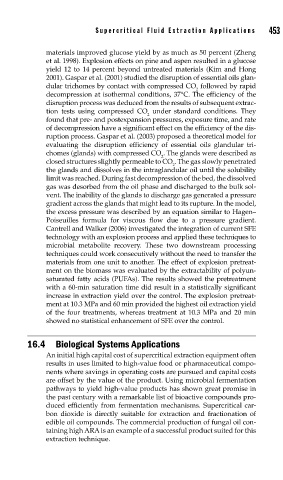Page 481 - Biosystems Engineering
P. 481
Super critical Fluid Extraction Applications 453
materials improved glucose yield by as much as 50 percent (Zheng
et al. 1998). Explosion effects on pine and aspen resulted in a glucose
yield 12 to 14 percent beyond untreated materials (Kim and Hong
2001). Gaspar et al. (2001) studied the disruption of essential oils glan-
dular trichomes by contact with compressed CO followed by rapid
2
decompression at isothermal conditions, 37°C. The efficiency of the
disruption process was deduced from the results of subsequent extrac-
tion tests using compressed CO under standard conditions. They
2
found that pre- and postexpansion pressures, exposure time, and rate
of decompression have a significant effect on the efficiency of the dis-
ruption process. Gaspar et al. (2003) proposed a theoretical model for
evaluating the disruption efficiency of essential oils glandular tri-
chomes (glands) with compressed CO . The glands were described as
2
closed structures slightly permeable to CO . The gas slowly penetrated
2
the glands and dissolves in the intraglandular oil until the solubility
limit was reached. During fast decompression of the bed, the dissolved
gas was desorbed from the oil phase and discharged to the bulk sol-
vent. The inability of the glands to discharge gas generated a pressure
gradient across the glands that might lead to its rupture. In the model,
the excess pressure was described by an equation similar to Hagen–
Poiseuilles formula for viscous flow due to a pressure gradient.
Cantrell and Walker (2006) investigated the integration of current SFE
technology with an explosion process and applied these techniques to
microbial metabolite recovery. These two downstream processing
techniques could work consecutively without the need to transfer the
materials from one unit to another. The effect of explosion pretreat-
ment on the biomass was evaluated by the extractability of polyun-
saturated fatty acids (PUFAs). The results showed the pretreatment
with a 60-min saturation time did result in a statistically significant
increase in extraction yield over the control. The explosion pretreat-
ment at 10.3 MPa and 60 min provided the highest oil extraction yield
of the four treatments, whereas treatment at 10.3 MPa and 20 min
showed no statistical enhancement of SFE over the control.
16.4 Biological Systems Applications
An initial high capital cost of supercritical extraction equipment often
results in uses limited to high-value food or pharmaceutical compo-
nents where savings in operating costs are pursued and capital costs
are offset by the value of the product. Using microbial fermentation
pathways to yield high-value products has shown great promise in
the past century with a remarkable list of bioactive compounds pro-
duced efficiently from fermentation mechanisms. Supercritical car-
bon dioxide is directly suitable for extraction and fractionation of
edible oil compounds. The commercial production of fungal oil con-
taining high ARA is an example of a successful product suited for this
extraction technique.

